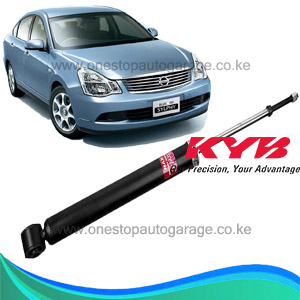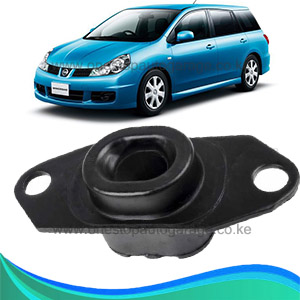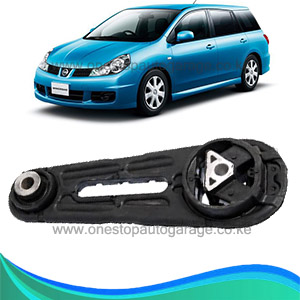-8%
Find the best Prices for Rear Engine Mount Nissan Wingroad Y12 in Nairobi, Kenya
In the intricate ballet of a vehicle’s mechanical orchestra, engine mounts play a silent but crucial role in providing stability, reducing vibrations, and absorbing shocks. These often-overlooked components form the backbone of the vehicle’s powertrain, securing the engine in place while ensuring a smooth and controlled driving experience. This comprehensive guide will explore the importance of engine mounts and shed light on the signs that indicate they may be worn out, requiring attention for sustained vehicle performance and driver comfort.
Importance of Engine Mounts:
- Vibration Isolation: Engine mounts serve as the primary means of isolating the engine’s vibrations from the vehicle’s chassis. The engine produces inherent vibrations during operation, and without proper isolation, these vibrations can transfer to the rest of the vehicle, leading to a less comfortable ride for occupants. Engine mounts, often made of rubber or other elastomeric materials, absorb and dampen these vibrations, ensuring a smoother driving experience.
- Stability and Alignment: Engine mounts play a crucial role in maintaining the stability and proper alignment of the engine within the vehicle. Proper alignment is essential for ensuring that all components of the powertrain, such as the transmission and exhaust system, work harmoniously. Engine mounts provide the necessary support to keep the engine in its designated position, preventing misalignments that could lead to operational issues and increased wear on other components.
- Noise Reduction: In addition to absorbing vibrations, engine mounts contribute to noise reduction within the vehicle. Vibrations from the engine can create noise if transmitted directly to the chassis. Engine mounts act as isolators, preventing direct metal-to-metal contact and minimizing the transmission of engine noise into the passenger compartment. This results in a quieter and more comfortable driving environment.
- Protection Against Shock: Engine mounts absorb shocks and impacts generated by irregularities in the road surface or sudden maneuvers. When driving over bumps or potholes, the mounts compress and expand, absorbing the shocks and preventing them from directly impacting the engine and transmission. This shock absorption capability contributes to the overall durability and longevity of the engine and surrounding components.
Signs of Worn-Out Engine Mounts:
- Excessive Engine Movement: One of the primary indicators of worn-out engine mounts is excessive engine movement. If the mounts are no longer providing adequate support, the engine may shift excessively during acceleration, deceleration, or when changing gears. Visually inspecting the engine while someone else operates the vehicle can reveal signs of abnormal movement, indicating the need for immediate attention.
- Vibration in the Cabin: As engine mounts wear out, their ability to dampen vibrations diminishes. This can result in increased vibrations being transmitted to the vehicle’s chassis and, subsequently, the cabin. If occupants feel an unusual increase in vibrations, especially during acceleration or at idle, it may be indicative of worn-out engine mounts. Addressing this issue promptly is crucial for maintaining driving comfort.
- Clunking or Thudding Noises: Worn-out engine mounts can lead to clunking or thudding noises, especially during abrupt acceleration or deceleration. These sounds occur as the engine shifts position due to inadequate support from the mounts. If drivers or passengers hear unusual noises coming from the engine bay, it is essential to have the engine mounts inspected to identify and address the source of the noise.
- Visible Wear or Damage: A visual inspection of the engine mounts can reveal signs of wear or damage. Cracks, tears, or visible deterioration in the rubber or elastomeric material indicate that the mounts may be reaching the end of their effective life. Additionally, if there is visible play or movement in the mounts when manually attempting to shift the engine, it suggests worn-out engine mounts.
- Misalignment of Engine Components: Worn-out engine mounts can contribute to misalignment of various engine components. This misalignment may be noticeable when inspecting parts such as the belts, hoses, or exhaust system. If components appear shifted or out of their normal position, it may indicate that the engine mounts are no longer providing proper support and require replacement.
- Burning Smell or Smoke: In extreme cases of engine mount failure, continued friction and movement can lead to overheating. This may result in a burning smell or even smoke emanating from the engine bay. If such signs are observed, it is crucial to address the issue immediately to prevent further damage and potential safety hazards.
- Increased Transmission Vibrations: Worn-out engine mounts can also impact the transmission system. Increased vibrations from the engine may be transmitted to the transmission, affecting its performance. Drivers may notice unusual vibrations or harsh shifting when accelerating or decelerating. Addressing these symptoms promptly is essential to prevent further damage to the transmission.
Conclusion:
Engine mounts, although often overlooked, are integral to the smooth operation, stability, and longevity of a vehicle. Recognizing the signs of worn-out engine mounts is crucial for maintaining optimal driving comfort, preventing excessive wear on other components, and ensuring the safety of the vehicle. Regular inspections, attentive listening for unusual noises, and addressing any identified issues promptly contribute to the overall health of engine mounts and support a pleasant and controlled driving experience. By staying vigilant and responsive to these signs, vehicle owners can uphold the integrity of their engine mounts, promoting both driver comfort and the longevity of their vehicles.



